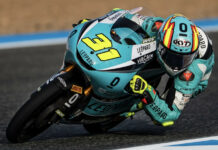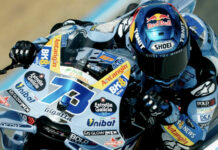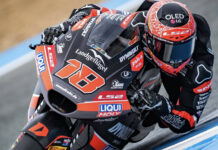Bridgestone slick compounds available: Front: Extra-soft & Soft. Rear: Soft, Medium & Hard (Asymmetric) Bridgestone wet tyre compounds available: Soft (Main) & Hard (Alternative) Yamaha Factory Racing’s Jorge Lorenzo won an intriguing Australian Grand Prix ahead of Repsol Honda’s Dani Pedrosa and his factory Yamaha stablemate Valentino Rossi. The new Phillip Island track surface proved to be unexpectedly harsh on tyres, particularly at the rear, resulting in a decision by race direction – following discussions with Bridgestone – to reduce the race distance to nineteen laps and mandate a pit stop where riders were required to change bikes equipped with a fresh set of tyres. Q&A with Shinji Aoki – Manager, Bridgestone Motorsport Tyre Development Department Last Sunday MotoGP witnessed its first flag-to-flag race in dry conditions. Can you explain what happened at Phillip Island? “Basically, due to the much improved track surface at Phillip Island this year, the rear slick tyre allocation we supplied for the Australian Grand Prix experienced extreme temperatures which affected their durability. The very high levels of traction offered by the tarmac resulted in some tyres having their tread torn off and cracked – a situation we definitely did not anticipate. When it became apparent that doing the full race distance on a single rear tyre was not feasible, we engaged in discussions with Dorna, the FIM and IRTA, who worked together to find a solution for the race. Considering the tyre allocation we had to work with, I am pleased at the outcome on Sunday as the crowd at Phillip Island, as well as fans around the world got to witness a safe and exciting race. The teams and riders showed great flexibility and professionalism in adapting their programme for a flag-to-flag race and for this they should be congratulated.” The original announcement of the flag-to-flag race was for a twenty-six lap race, then on Sunday this was revised to nineteen laps. Why was the duration of the race changed? “The decision by race direction to make a twenty-six lap race came after our advice that the maximum stint on a rear slick tyre must be fourteen laps, following our tyre analysis on Saturday. With our mind on the safety of the riders, we asked the riders to do long runs on the harder option rear slicks In Sunday’s warm up session to see if running conditions were different compared to the day before, which could have a result on tyre longevity. The analysis of the tyres from warm up showed that on Sunday, ten laps was a safer distance on a single rear tyre so for a one stop race, nineteen laps was deemed the best race distance. It seems that the improved setup of the bikes in Sunday warm-up yielded better performance for the riders and hence increased the stress on tyres even further compared to Saturday.” What was it about the track surface at Phillip Island that caused problems with the tyres? “We knew that the track had been resurfaced at Phillip Island resulting in the track being more severe and despite having special extra-hard rear slicks delivered to the circuit to address this change, the improvement in the condition of the track surface caused us problems. Although we have to investigate our used tyres and look at telemetry data from the teams to reach a conclusion on all the contributing factors, the overall problem was sustained periods of very high tyre temperature that before this weekend, were unprecedented at this circuit. Our initial findings suggest it wasn’t just the vastly increased grip of the tarmac itself that caused the problem. The lack of bumps in the corners meant the tyres maintained more constant contact with the tarmac and this drove tyre temperatures even higher. When you look at the best race lap time from this year, it is over two seconds quicker than last year, which shows just how much extra traction – and potential for higher tyre temperatures – the new tarmac offers. We expected an increase in tyre temperatures this weekend and prepared for this, but the extreme temperatures that occurred were far beyond our expectations.” An extra-hard rear slick was tested by the twelve works riders in Free Practice 4, but wasn’t used for the race. Why? “The extra-hard rear slicks used in FP4 offered no benefit compared to the hard compound slick that was originally allocated to riders. The extra-hard rear slick suffered from the same heat problems and also offered less grip than the hard rear, so it was withdrawn as a race option. Generally, harder rubber compounds offer better heat resistance, yet this wasn’t the always the case last weekend. Our hard compound rear slick fared better than our medium compound rear, but the extra-hard rear slick didn’t cope as well as the hard option. This seems to be another peculiarity with the new Phillip Island track surface and this is something our engineers are currently investigating.” How will Bridgestone ensure such problems at Phillip Island are not experienced in future races? “It is evident from what we now know about the condition of the Phillip Island circuit that we will need to undertake testing here before the race in October next year. As Phillip Island isn’t currently used for any IRTA group tests or private team tests, we are currently negotiating a way by which we can test here next year with some MotoGP riders before the next Australian Grand Prix in October. This way, we can use the data obtained to develop tyres that better suit the new track surface.” Are you confident that with testing, Bridgestone will be able to make tyres that last a full race distance for next year’s Australian Grand Prix? “Yes, everyone at Bridgestone is confident that if we test next year with factory riders at Phillip Island early next year, we can develop tyres for this circuit that will last the full race distance of twenty-seven laps. It will be a big challenge for us, but one we will pursue diligently. Creating new slick tyres that will have enough durability and heat-resistance on the new surface, yet still deliver the grip levels and warm-up performance that is required at Phillip Island will be made a priority for the engineers at Bridgestone’s Technical Centre in Japan.”
Bridgestone Sums Up The MotoGP Weekend At Phillip Island
Bridgestone Sums Up The MotoGP Weekend At Phillip Island
© 2013, Roadracing World Publishing, Inc.






